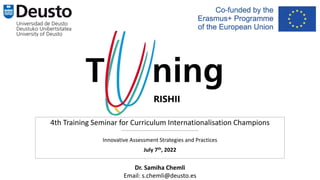
Innovative Assessment Strategies and Practices.pdf
- 1. 4th Training Seminar for Curriculum Internationalisation Champions ------------------------------------------ Innovative Assessment Strategies and Practices July 7th, 2022 Dr. Samiha Chemli Email: s.chemli@deusto.es
- 2. Content I. ASSESSMENT TECHNIQUES ACROSS THE PROGRAM II. MARKING RUBRICS - ALIGNMENTS
- 3. I. ASSESSMENT OF INTERNATIONALISED COMPONENTS ACROSS THE PROGRAM
- 4. INNOVATIVE ASSESSMENT – WICKED PROBLEM Micro •The individual Academic MESO •Subject discipline Macro •National and International
- 5. 1. The assessment cycle (Gravells 2021) Initial Assessment Assessment Planning Assessment Activity Assessment Feedback Review of Progress
- 6. 2. The aspects involved throughout the assessment process ACCOUNTABILITY ACHIEVEMENT ASSESSMENT STRATEGIES BENCHMARKING EVALUATION PROGRESSION TRANSPARENCY
- 7. 3. PRINCIPLES OF ASSESSMENTS – VARCS requirements VALID – the work is relevant to what is being assessed and is at the right level. AUTHENTIC – the work has been produced solely by the learner. RELIABLE – the work is consistent over time. CURRENT – the work is still relevant at the time of assessment. SUFFICIENT – the work covers all the requirements at the time.
- 8. 3. Other principles of assessment can include: COMMUNICATION CONTINUING PROFESSIONAL DEVELOPMENT (CPD) EQUALITY AND DIVERSITY ETHICS HEALTH AND SAFETY MOTIVATION QUALITY ASSURANCE RECORD KEEPING RESPONSIBILITY SMART STANDARDISATION
- 11. 5. ASSESSMENT TECHNIQUES Routine evaluation of students Oral questioning Quizzes and term papers Independent and group work Exercice-based homework Written essays Oral test /presentation discussion Self and peer assessments
- 12. Examples of informal and formal assessment methods Informal Methods Formal Methods Case Studies Assignments Crosswords Essays Discussions Examinations Journals/Diaries Multiple Choice Questions Peer And Self-assessment Observations Puzzles Professional Discussions Practical Activities Recognition Of Prior Learning Projects Reviewing Learner Evidence Quizzes Tests Role Plays Witness Testimonies Worksheets Written Questions
- 13. 6. BEST PRACTICES – FOR CONTINUOUS IMPROVEMENT Use Continuous and periodic forms of assessment Optimally Align Assessments methods and criteria to the competences and the learning outcomes •Articulate internationalised LOs and assess them It needs to be Transparent, consistent and fair Ensure Assessment is inclusive and equitable, especially considering students from different backgrounds •Avoid the one-size-fits- all assessment method •Provide clearly articulated assessment criteria and marking rubric
- 14. However, we need to ensure assessment and feedback contribute to learning rather than being simply a means of capturing evidence of stated outcomes’ achievement, thus assessment must be: • Serve student learning. • Be fit for purpose. • Be a deliberative and sequenced series of activities demonstrating progressive achievement. • Be dialogic. • Be authentic.
- 15. II. MARKING RUBRICS - ALIGNMENTS
- 16. 1. COMMON MISCONCEPTIONS ABOUT RUBRICS • Confusing learning outcomes with tasks • Confusing rubrics with requirements or quantities • Confusing rubrics with evaluative rating scales
- 17. 2. THE ESSENTIALS OF COMPETENCY- BASED LEARNING RUBRICS Rubrics should have clearly articulated competencies and learning outcomes as their base 01 They are intended to give clarity to students about what and why they’re learning 02 A well-written rubric should essentially be a tool for teachers to understand the quality performance of the student work collaboratively 03 Rubrics should ultimately measure performance, reflect on learning, and plan the next steps 04
- 18. 3. ALIGN ASSESSMENTS TO COMPETENCIES Competencies A1 A2 A3 A4 Final exam General Competency: Entrepreneurial Spirit: To elaborate projects under their own initiative, with the purpose of enhancing an international business opportunity and assuming the risks it carries. 5 5 SC1: Collect, analyze, synthesize, and evaluate information systems (legal, economic, financial, etc) inherent to global tourism organizations in order to make decisions: To promote and sell tourist products. 10 10 10 SC2: analyze critically the most common business models and design the departmental structures that best suit the different tourism companies and organizations: To manage the best suppliers in order to guarantee the elaboration of the best possible product 5 5 10 SC3: Apply to the different tourism companies and organizations the basic management principles: To understand the different stages and functions of intermediation and transport management 10 SC4: plan and manage financial resources of tourism organizations: To obtain the highest level of income for a business 5 5 SC5: plan and manage human resources of tourism organizations: To establish the stages in the process of management of human resources in these tourism companies and organizations. 10 SC6: apply basic marketing principles to large scale tourism companies and organizations: 1. To establish an adequate marketing mix for every type of tourism intermediaries and transport business. 5 2. To design promotion strategies for tourist intermediaries and transport companies and organizations. 5 Total 100
- 19. 4. LOs & ASSESSMENTS • With a clear vision for internationalization • Clear and measurable DEVELOP GLOBAL LOS • To measure the achievement of the intended International and intercultural LOs • The mix of assessments will determine whether a student has met the intended learning outcomes ASSESS THE GLOBAL LOs
- 20. Partial sample of the grading rubric used in the course, example from Hussain & Jaeger, 2018
- 21. ALIGN ASSESSMENTS TO GLOBAL LOS Marking Rubric – Assessment 1 Assessment criteria Distinction Pass Fail Criteria 1 The student identifies more than 3 benefits of project management to IME The student identifies 3 benefits of project management to IME The student identifies less than 3 benefits of project management to IME LO1 - Recognize benefits of project management to international Mega events Weight: 5% Criteria 2… LO1 & LO4 The student justifies all the answers…. The student justifies 3 of the selected benefits The student justify les…. Question Read the text below and identify at least 3 benefits of project management to IME? You are requested to justify all of them
- 22. TAKEAWAYS • Using multiple assessments is the most effective to assess learning • Align assessments to the Global LOs and to the competencias • Revise systematically the assessment techniques for continuous improvement • The marking rubric – DO IT WELL
- 24. THANK YOU Dr. Samiha Chemli Associate Professor – Hospitality and Tourism Email: s.Chemli@deusto.es